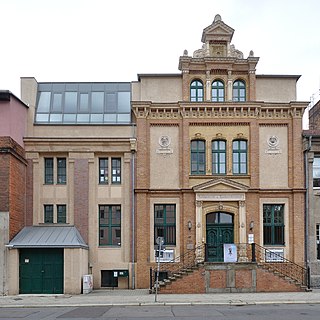Related Research Articles

The Technische HochschuleMittelhessen University of Applied Sciences is a German Fachhochschule for bachelor's and master's studies in the cities of Giessen, Friedberg, and Wetzlar.

The Technische Universität Darmstadt, commonly known as TU Darmstadt, is a research university in the city of Darmstadt, Germany. It was founded in 1877 and received the right to award doctorates in 1899. In 1882, it was the first university in the world to set up a chair in electrical engineering. In 1883, the university founded the first faculty of electrical engineering and introduced the world's first degree course in electrical engineering. In 2004, it became the first German university to be declared as an autonomous university. TU Darmstadt has assumed a pioneering role in Germany. Computer science, electrical engineering, artificial intelligence, mechatronics, business informatics, political science and many more courses were introduced as scientific disciplines in Germany by Darmstadt faculty.

Bernhard Hans Henry Scharoun was a German architect best known for designing the Berliner Philharmonie and the Schminke House in Löbau, Saxony. He was an important exponent of organic and expressionist architecture.

The Gottfried Wilhelm Leibniz Prize, or Leibniz Prize, is awarded by the German Research Foundation to "exceptional scientists and academics for their outstanding achievements in the field of research". Since 1986, up to ten prizes have been awarded annually to individuals or research groups working at a research institution in Germany or at a German research institution abroad. It is considered the most important research award in Germany.

The Berlin-Brandenburg capital region is one of the most prolific centers of higher education and research in the world. It is the largest concentration of universities and colleges in Germany. The city has four public research universities and 27 private, professional and technical colleges (Hochschulen), offering a wide range of disciplines. Access to the German university system is tuition free.

The Darmstadt University of Applied Sciences, also known as h_da, is a University of Applied Sciences located in Darmstadt, Germany.

Akaflieg is an abbreviation for Akademische Fliegergruppe, groups of aeronautical engineering students from individual German Technical Universities, pre and postwar, who design aircraft, often gliders.

Gerhard Ertl is a German physicist and a Professor emeritus at the Department of Physical Chemistry, Fritz-Haber-Institut der Max-Planck-Gesellschaft in Berlin, Germany. Ertl's research laid the foundation of modern surface chemistry, which has helped explain how fuel cells produce energy without pollution, how catalytic converters clean up car exhausts and even why iron rusts, the Royal Swedish Academy of Sciences said.

A Kunstgewerbeschule was a type of vocational arts school that existed in German-speaking countries from the mid-19th century. The term Werkkunstschule was also used for these schools. From the 1920s and after World War II, most of them either merged into universities or closed, although some continued until the 1970s.
Thomas Herzog is a German architect from Munich known for his focus on climate and energy use through the use of technologically advanced architectural skins. He began with an interest in pneumatics and became Germany's youngest architecture professor at the age of 32. He established his firm Herzog + Partner in 1983.

This article shows a list of railway stations in Germany. The list is subdivided per federal state. Due to the number of railway stations it shows a selection of the principal stations and links to related state articles. Where there are 2 or more passenger stations in a large town or city, the most important is often designated by the Deutsche Bahn as the Hauptbahnhof, of which there are 122 in total.
Hans Günter Merz, better known as HG Merz is a German architect and museum designer. He is the founder and director of hg merz architekten museumsgestalter, an architecture office that specializes in museum and exhibition design and in refurbishing listed buildings. The office has branches in Stuttgart and Berlin.

IU International University of Applied Sciences is a private for-profit University of Applied Sciences based in Erfurt, Germany.

Johann-Dietrich "Jan" Wörner is a German civil engineer, university professor and former president of Technische Universität Darmstadt. He served as chairman of the executive board of the German Aerospace Center DLR from 1 March 2007 to 30 June 2015. On 1 July 2015, he succeeded Jean-Jacques Dordain as Director General of the European Space Agency.

Alwin Oswald Walther was a German mathematician, engineer and professor. He is one of the pioneers of mechanical computing technology in Germany.

Alfred Jacoby is a German architect and architectural lecturer, principally known for his output of synagogues in post-war Germany, development of a modern Jewish religious architectural vernacular, his teaching positions as a lecturer and professor of architecture, and his active architectural practice in Frankfurt am Main. Jacoby was born in Offenbach, in 1950, to a Polish father, and was educated at the University of Cambridge and Eidgenössische Technische Hochschule. Credited with being the first postwar architect in Germany to develop a distinctive Jewish vernacular for synagogue buildings, he is recognised as Germany's leading synagogue architect. Jacoby was Director of the Dessau Institute of Architecture at the Anhalt University of Applied Sciences, Bauhaus Dessau, from 2000 until 2017.

Volker Staab is a German architect.
References
- ↑ Alanus Hochschule
- ↑ ABK Stuttgart
- ↑ Städelschule
- ↑ RWTH Aachen
- ↑ TU Berlin Archived 2008-03-29 at the Wayback Machine
- ↑ "TU Cottbus". Archived from the original on 2013-08-21. Retrieved 2018-09-06.
- ↑ "TU Darmstadt". Archived from the original on 2007-12-24. Retrieved 2020-03-07.
- ↑ TU Karlsruhe Archived 2008-04-05 at the Wayback Machine
- ↑ TU München
- ↑ UdK Berlin
- ↑ "Bauhaus University Weimar". Archived from the original on 2015-05-26. Retrieved 2020-03-07.
- ↑ Uni Hanover
- ↑ Uni Kassel Archived 2014-02-01 at the Wayback Machine
- ↑ Uni Stuttgart
- ↑ HS Bremen Archived 2008-01-17 at the Wayback Machine
- ↑ HS21
- ↑ Hochschule Ostwestfalen-Lippe
- ↑ Hochschule Darmstadt
- ↑ FH Frankfurt Archived 2011-10-04 at the Wayback Machine
- ↑ Munich University of Applied Sciences Archived 2014-02-26 at the Wayback Machine